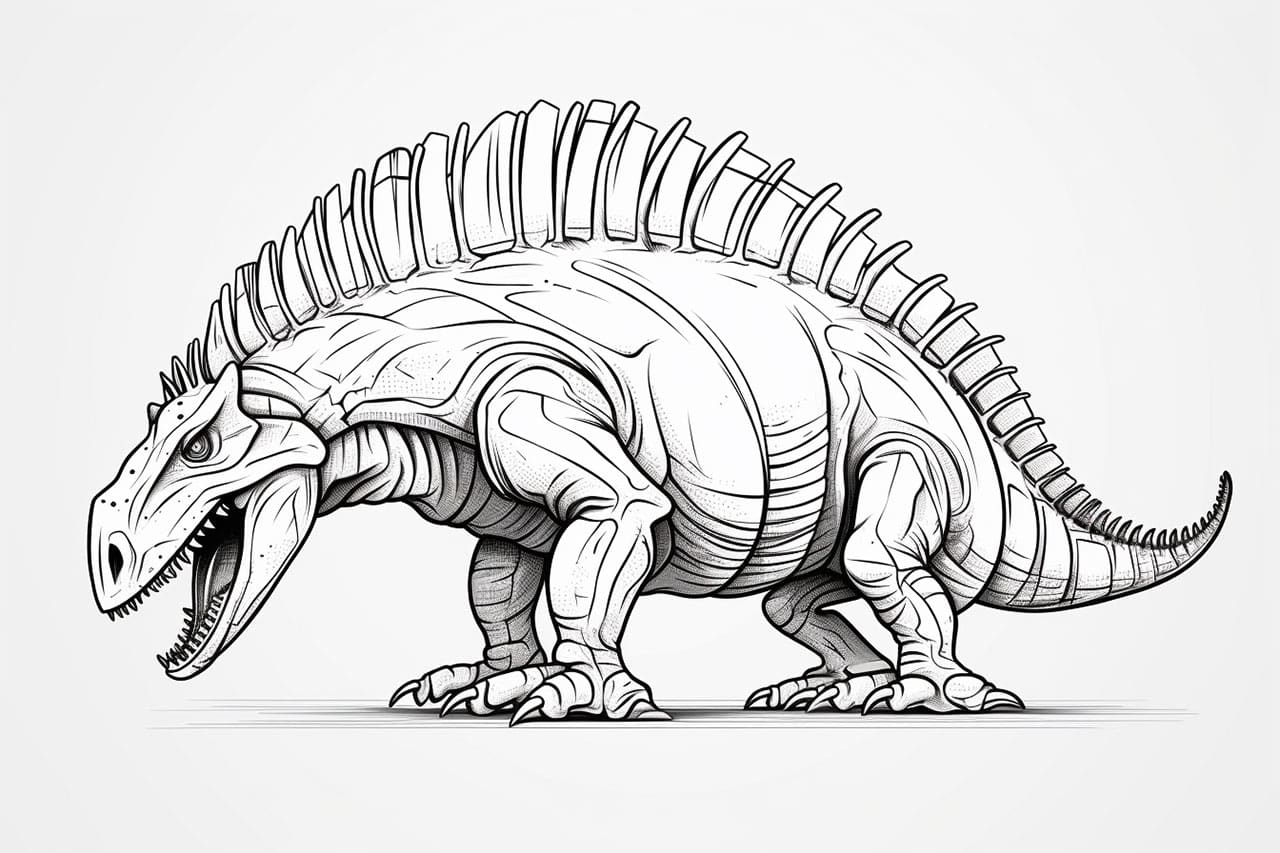Welcome to this step-by-step guide on how to draw a Spinosaurus! In this tutorial, I will walk you through the process of creating a realistic and detailed drawing of this magnificent dinosaur. Whether you are a beginner or an experienced artist, you will find this guide helpful in capturing the essence of the Spinosaurus on paper. So, let’s get started!
Materials Required:
Before we begin, make sure you have the following materials ready:
- Pencil
- Eraser
- Drawing paper
- Fine-tip markers or pens (optional)
- Colored pencils or markers (optional)
Having these materials on hand will ensure that you have everything you need to complete the drawing.
Step 1: Basic Proportions
To start, lightly sketch the basic proportions of the Spinosaurus. Begin with a circle for the head and then add a long oval shape for the body. Connect the head and body with a slightly curving neck line. Remember, at this stage, you’re only drawing basic shapes, so keep the lines light and simple.
Step 2: Outline the Body
Using the basic shapes as a guide, start outlining the body of the Spinosaurus. Pay attention to the curves and angles of its long neck, back, and tail. Remember, the Spinosaurus had a sail-like structure on its back, so make sure to include that in your drawing. Keep your lines fluid and confident.
Step 3: Add Details
Now that you have the basic outline, it’s time to add some details to bring the Spinosaurus to life. Start by sketching the head and adding the characteristic long and narrow snout. Then, add the eyes, nostrils, and mouth. Don’t forget to include the sharp teeth!
Next, focus on the details of the sail on its back. The sail had many bony spines, so make sure to add those along the length of the sail. Take your time with this step, as the spines contribute to the unique appearance of the Spinosaurus.
Step 4: Refine the Shape
Once you have added the necessary details, take a step back and assess the overall shape of your drawing. Make any adjustments needed to ensure the proportions are accurate and the shape is well-defined. Erase any unnecessary lines and refine the contours of the Spinosaurus.
Step 5: Add Texture and Shading
To add depth and realism to your drawing, it’s time to add texture and shading. Use your pencil to create small, quick strokes that mimic the scales of the dinosaur. Start by shading the body, paying attention to areas where shadows would naturally fall. Gradually build up the shading, using darker tones for the areas that are in shadows.
Step 6: Finalize the Drawing
Now that you have added texture and shading, take a moment to evaluate your drawing. Make any final adjustments or additions to enhance the overall appearance of the Spinosaurus. If you prefer, you can also use fine-tip markers or pens to outline and define certain areas of the drawing.
Conclusion
Congratulations on completing your Spinosaurus drawing! By following these step-by-step instructions, you have successfully captured the majestic beauty of this fascinating dinosaur. Remember, practice makes perfect, so don’t hesitate to try drawing the Spinosaurus multiple times to improve your skills. Happy drawing!
Fun Facts About Spinosaurus
- Size and Length: Spinosaurus was one of the largest known carnivorous dinosaurs, potentially reaching lengths of up to 50-60 feet (15-18 meters) from snout to tail. This makes it larger than other famous predators like Tyrannosaurus rex and Giganotosaurus.
- Distinctive Sail: One of the most distinctive features of Spinosaurus was the sail-like structure on its back. This sail was formed by elongated neural spines extending from its vertebrae and may have served several purposes, including thermoregulation, display, or possibly even propulsion in water.
- Aquatic Adaptations: Recent evidence suggests that Spinosaurus was well-adapted to a semi-aquatic lifestyle. Its long, narrow skull, conical teeth, and likely webbed feet indicate that it spent a significant amount of time in water, possibly hunting fish and other aquatic prey.
- Dietary Preferences: While Spinosaurus was primarily a carnivore, its diet likely consisted of a variety of prey, including fish, small dinosaurs, and other aquatic animals. Its elongated jaws and conical teeth were well-suited for catching slippery prey like fish.
- Discovery and Fossil Record: The first Spinosaurus fossils were discovered in Egypt in the early 20th century by German paleontologist Ernst Stromer. Unfortunately, many of these original fossils were destroyed during World War II, leading to gaps in our understanding of this dinosaur.
- Bipedal and Quadrupedal: Spinosaurus is believed to have been capable of both bipedal and quadrupedal locomotion. While it likely walked on two legs on land, it may have moved on all fours while in water, using its powerful limbs to propel itself through aquatic environments.
- Convergent Evolution with Crocodiles: Some researchers believe that Spinosaurus may have exhibited convergent evolution with modern crocodiles, developing similar adaptations for life in aquatic habitats. This includes features such as a long, streamlined body, dense bones for buoyancy, and sensory adaptations for underwater hunting.
- Habitat: Spinosaurus inhabited the lush river deltas and wetland environments of what is now North Africa during the Late Cretaceous period, approximately 112 to 93 million years ago.
- Iconic Encounter: In popular culture, Spinosaurus gained widespread recognition after its dramatic encounter with a Tyrannosaurus rex in the movie “Jurassic Park III.” While the accuracy of this portrayal has been debated, it has undoubtedly cemented Spinosaurus as one of the most iconic dinosaurs in modern media.
- Ongoing Research: Spinosaurus continues to be a subject of intense study and debate among paleontologists. New discoveries and analyses are shedding light on its biology, behavior, and evolutionary significance, challenging previous assumptions and leading to exciting new insights into this enigmatic dinosaur.









